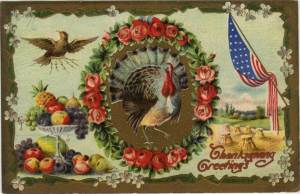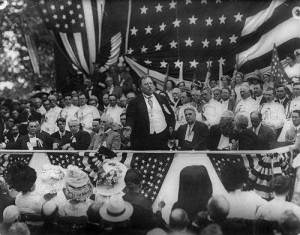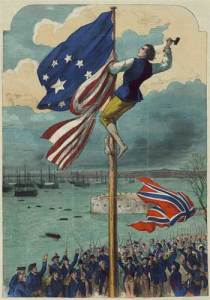Giving thanks and waving flags

In 1903, 300 children who attended St. Thomas Catholic School in Wilmington, Delaware, celebrated Thanksgiving Day in an unusual way. After attending Mass, they “adjourned to the lawn about the church,” according to a newspaper, where “a new American flag was raised.”
While the linking of Thanksgiving and flags is rare in the 21st century, it was common in earlier times. Americans back then made the connection between the Pilgrim feast and the birth of the United States. As a result, the first European settlers and the nation were regularly celebrated together.
In 1895, for example, citizens in Trenton, New Jersey, dedicated a 100-foot flagpole on Thanksgiving Day. The Evening Times informed readers that the staff was made from pine and “embedded in stone and cement….For holiday display, [the flag] will be twenty by thirty-six feet, with thirteen stars.”

When President Taft issued his 1911 Thanksgiving proclamation, he “earnestly” called on “my countrymen and upon all that dwell under the flag of our beloved county to meet in their accustomed places of worship” to offer “praise to Almighty God.”
The people of Harrisburg, the capital of Pennsylvania, had another reason to marry the flag and the holiday in 1917. “The services this year will be more impressive than in former years because of the war,” noted The Patriot newspaper.
After listing several planned events, the article cited “an appropriate Thanksgiving program” that was sponsored by the Fourth Reformed Church. “Prayers will be offered for the sailors and soldiers,” said the story, adding that “a service flag will be unfurled. There are sixteen stars in the flag.”

New York City had a special reason for tying Thanksgiving to the flag, a reason that reached back to the American Revolution. On November 25, 1783, British troops left the city, boarded ships and sailed home, marking the final removal of English authority from the new United States.
The city dubbed the event Evacuation Day, and its late-November date coincided with Thanksgiving celebrations. In 1880, in fact, the two fell on the same day, providing another reason to link flags and giving thanks.
That year, a few veterans of the War of 1812 attended religious services and lifted an American flag on the Battery and another at an old fort in Central Park. Giving three cheers, they knew they had a profound reason for giving thanks and flying the star-spangled banner.
